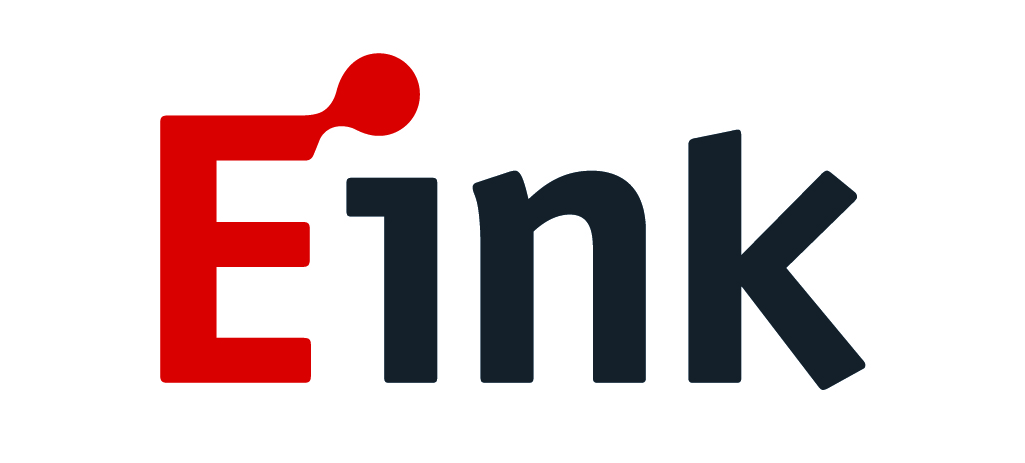
Once the electronic ink microcapsules or microcups have been created, the ink is laminated onto a roll of plastic film that can be cut into different shapes and sizes. These cut parts are then affixed to layer of circuitry that can create an electric field across the microcapsule or microcup. It is this electric field that causes the ink to move within the microcapsules or microcups and switch from one state, or color, to another.

Electronic ink microcapsules have been created and laminated onto a roll of plastic film. A roll of ePaper runs down by Charles River, Boston.
The E Ink plastic film can be applied onto virtually any surface, including glass, plastic, fabric and even paper. Ultimately electronic ink will permit most any surface to become a display, bringing information out of the confines of traditional devices and into the world around us.
Most customers will find a module solution the easiest and fastest route to market; a module is a completed display, including TFT, Ink layer, Protective Sheet, driver electronics and connector. It is ready for integration into a customer's end product design. E Ink sells modules in a variety of configurations.
For those customers who have module making capacities in house, including access to a TFT fab, E Ink will consider joint development partnerships. Contact our sales team for further information.
E Ink manufacturers a number of EPD films, with different attributes depending on application needs.
E Ink Carta™ delivers a dramatic 50% increase in contrast over earlier generations, giving displays a contrast ratio close to that of a paperback book. The crisp text and detailed graphics are also highly readable in direct sunlight. Carta's 16 levels of grey produce the sharpest rendering of images with smooth tones and rich detail.
E Ink Carta supports the Regal™ technology for image updates. Regal virtually eliminates the need for a full refresh, giving the viewer smoother viewing transitions.
E Ink Carta modules consist of a TFT (thin film transistor), Ink layer and Protective Sheet. In addition, product designers can include a touch solution, which is incorporated into the module stack. E Ink currently offers digitizer and capacitive touch solutions. Digitizer touch technology utilizes a stylus to update the display, with the touch sensor sitting under the TFT. Capacitive touch technology utilizes finger swipes, and is placed on top of the display module. E Ink's touch solutions will not affect the reflectivity of the display.
E Ink Carta Displays are ideal for a variety of dynamic content applications including:
E Ink Pearl™ gives eReaders a contrast ratio close to that of a paperback book. The crisp text and detailed graphics are also highly readable in direct sunlight. Pearl's 16 levels of grey produce the sharpest rendering of images with smooth tones and rich detail.
E Ink Pearl offers update times ranging from 50-250ms. In addition, E Ink Pearl supports localized animation for more enticing advertising content for eNewspaper or eMagazines and a richer educational experience in eTextbooks.
E Ink Pearl modules consist of a TFT (thin film transistor), Ink layer and Protective Sheet. In addition, product designers can include a touch solution, which is incorporated into the module stack. E Ink currently offers digitizer and capacitive touch solutions. Digitizer touch technology utilizes a stylus to update the display, with the touch sensor sitting under the TFT. Capacitive touch technology utilizes finger swipes, and is placed on top of the display module. E Ink's touch solutions will not affect the reflectivity of the display.
E Ink Pearl Displays are ideal for a variety of dynamic content applications including:
E Ink Spectra™ is the first three pigment electronic ink offered in mass production and is available for retail and electronic shelf tag labels. EPDs using Spectra offer the same high-contrast, sunlight readable, low-power performance attributes of our other display types - now with a pop of color. The first generation of Spectra features black, white and red or yellow pigments, and we expect to release additional colors in the future.
By using electronic shelf labels (ESL) with E Ink's technology, retailers have the ability to change pricing strategies as needed in real time, allowing them to stay one step ahead of competitors while attracting consumers based on changing market conditions. Spectra allows retailers to elevate the impact of their ESLs, by adding color to logos and quickly directing consumers' attention to important information, such as product sales and promotions.
Spectra works similarly to our other inks, in that we apply a charge to our pigments, and to a top and bottom electrode to facilitate movement. However, Spectra is utilizing a microcup ink structure, rather than the microcapsules we are known for.
E Ink Spectra has been tuned for non-eReader applications, and is ideal for electronic shelf labels (ESLs), medical and logistics markets.
Learn more about Spectra ink.
E Ink Aurora™ was developed to address retailers' needs to integrate digital signage into cold temperature display cases, such as refrigerators or freezers. With operating temperature ranges of -15 to 10 degrees C and 0 to 50 degrees C, Aurora offers the same benefits as E Ink's other display platforms - paper-like readability with a wide viewing angle. In addition, displays using Aurora are low power, running off of 2 small cell batteries, with a life-time of 5 years.

E Ink Aurora has been tuned for non-eReader applications, and is ideal for electronic shelf labels (ESLs) and smart cards in the retail, medical and logistics markets.
E Ink Prism™ was created for the architecture and design markets. Manufacturers and designers have the ability to integrate innovative films with architectural products to dynamically change colors, patterns, and habitats. E Ink Prism utilizes E Ink’s bi-stable ink technology in a film that can transform architectural materials into dynamic, one of a kind experiences and designs. E Ink Prism can change the color of a wall, ceiling panel, or entire room instantly, at the flip of a switch.
It doesn’t stop at color. Programmable patterns and shapes can be integrated to create designs or function. Doors can indicate if a conference room is occupied, wall designs can respond to noise, temperature, or motion in the room. Whatever the idea, the opportunities are endless and only limited by a designer’s imagination.
E Ink SURF Segmented displays are ultra-low power, thin, and rugged. E Ink's unique reflective display technology is sunlight readable and can display an image with no power. This enables engineers and designers to add displays to products where power and space limitations have made it impossible to do so before.
E Ink Segmented displays can be manufactured in any 2D shape such a circle, triangle, or abstract shape, enhancing industrial designs. In addition, E Ink's unique capabilities allow for the foreground and background to be reversed from black on white or white on black.
E Ink offers two types of Segmented displays: Segmented Display Cells (SDCs), and Segmented Display Modules (SDMs).
SDCs are independent display cells that do not include any embedded electronics; they can be driven at either 5V or 15V. Typically, SDCs are used in simpler designs with lower segment counts and fewer pin outs. Designs that have adequate space and less restrictive PCB integration needs are ideal for SDC applications.
SDMs include an integrated E Ink display driver for a complete display solution, typically for designs that have demanding integration requirements. SDMs simplify the integration effort by reducing the number of pin outs required between the MCU and display. As a result, less space is needed for connection to the PCB.
Applications for the technology are broad, including a wide variety of consumer electronics, watches, medical devices, industrial gauges, PC accessories, smart cards, electronic shelf labels, and mobile communications.